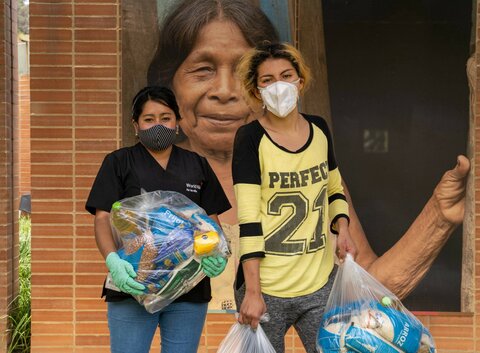High cost of healthy diet puts billions at risk of malnutrition, says food security report

By Peyvand Khorsandi
There are currently 3 billion people who cannot afford a healthy diet, according to ‘The State of Food and Nutrition in the World 2020', also known as the SOFI report, published by the Food and Agriculture Organization, in collaboration with fellow UN agencies including the World Food Programme (WFP).
In order to save lives and achieve zero hunger by 2030, the gap between the nutrition people need and what they are able to access has to be closed, starting with the most vulnerable and those for whom the divide is the greatest. Healthy diets are out of reach for at least 40 percent of the world's population.
Coronavirus and hunger: WFP ready to assist largest number of people ever

The worst affected are people who cannot even access enough food to meet their basic energy needs. WFP estimates that pressures wrought by coronavirus pandemic are expected to push another 121 million people into hunger. In the 83 countries where WFP operates, there are set to be 270 million acutely hungry people by the end of the year, largely due to the socioeconomic impact of the pandemic.

"Until the day we have a medical vaccine, food is the best vaccine against chaos," WFP's Executive Director David Beasley has said. "Without it, we could see an increase in social unrest and protests, a rise in migration, deepening conflict and widespread undernutrition among populations that were previously immune from hunger."
So, where do we start to mitigate the devastating consequences of high unaffordability of healthy diets which is now further aggravated by the COVID-19 consequences? More to the point, how can the poorest — those for whom a healthy diet is furthest out of reach — be supported?

At least 185 million people cannot afford the basic staples they need for physical energy on a day-to-day basis. In many low- and middle-income countries, even meeting essential nutrient needs is impossible — 1.5 billion people cannot afford to secure their needs in terms of essential nutrients.
The SOFI report shows that in poorer countries' fragile settings, the cost of a diet that provides people with just sufficient energy — as opposed to one that is nutrient-rich too — is usually only slightly higher than in more stable countries.

Squeezes on supply, however, cause the cost of a diet with sufficient nutrients to rocket — more expensive nutritious foods become difficult to source.
For example, in north Burundi, south Madagascar, the Tanganyika region in the Democratic Republic of the Congo, Maradi and Zinder in Niger, and the Dogon plateau in Mali, a nutrient-adequate diet would be unaffordable for over 90 percent of households.
In the Democratic Republic of Congo, Somalia and the Karamoja region in Uganda, rural markets tend to offer significantly poorer varieties of food than urban markets, especially when it comes to meat, fish and dairy.

In the most fragile settings, the cost of a nutrient-adequate diet was found to be four to seven times higher than the cost of one geared to meets energy needs alone, whereas it is about three times higher in stable contexts.
To prevent the devastating consequences this brings, we must prioritize the most vulnerable — children aged under 2, pregnant and breastfeeding women and adolescent girls; the poorest who are acutely hungry; people who live below the poverty line; and those unable to even afford to meet their nutrient needs, let alone secure a healthy diet.
Recognizing that healthy diets are dependent on food systems that enable them, WFP works with governments, local authorities, communities, the private sector and other interested partners to support both the supply and demand side of food systems, and bring healthy nutritious foods within reach of everyone, including people living in some of the most fragile contexts.
